NGC 6240 as seen with ALMA (top right) and the Hubble Space Telescope (combined image on the left and zoomed in on the bottom right). In the ALMA image, the molecular gas is blue and the black holes are the red dots. The ALMA image provides the sharpest view of the molecular gas around the black holes in this merging galaxy.
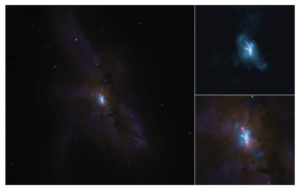
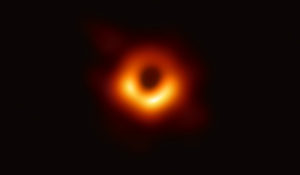
Astronomers Capture First Image of a Black Hole
The Event Horizon Telescope (EHT) — a planet-scale array of eight ground-based radio telescopes forged through international collaboration — was designed to capture images of a black hole. In coordinated press conferences across the globe, EHT researchers revealed that they succeeded, unveiling the first direct visual evidence of a supermassive black hole and its shadow. The shadow of a black hole seen here is the closest we can come to an image of the black hole itself, a completely dark object from which light cannot escape. The black hole’s boundary — the event horizon from which the EHT takes its name — is around 2.5 times smaller than the shadow it casts and measures just under 40 billion km across. While this may sound large, this ring is only about 40 microarcseconds across — equivalent to measuring the length of a credit card on the surface of the Moon. Although the telescopes making up the EHT are not physically connected, they are able to synchronize their recorded data with atomic clocks — hydrogen masers — which precisely time their observations. These observations were collected at a wavelength of 1.3 mm during a 2017 global campaign. Each telescope of the EHT produced enormous amounts of data – roughly 350 terabytes per day – which was stored on high-performance helium-filled hard drives. These data were flown to highly specialised supercomputers — known as correlators — at the Max Planck Institute for Radio Astronomy and MIT Haystack Observatory to be combined. They were then painstakingly converted into an image using novel computational tools developed by the collaboration.
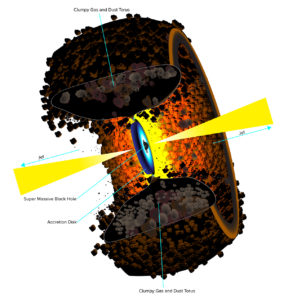
A Unified AGN Model
Artist’s conception of the Unified AGN Model. The unified model includes the central black hole, a rotating disk of infalling material surrounding the black hole, and the jets speeding outward from the poles of the disk. In addition, to explain why the same type of object looks different when viewed from different angles, a thick, dusty, doughnut-shaped “torus” is included, surrounding the inner parts. The torus obscures some features when viewed from the side, leading to apparent differences to the observer, even for intrinsically similar objects. Astronomers generically call this common set of features an active galactic nucleus (AGN).
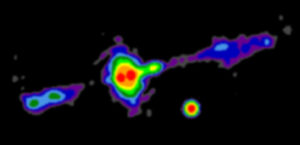
VLA Image of Torus in Cygnus A
VLA image of the central region of the powerful radio galaxy Cygnus A, showing the doughnut-shaped torus surrounding the black hole and accretion disk.
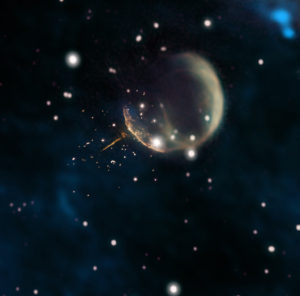
Cannonball Pulsar
Observations using the Very Large Array (orange) reveal the needle-like trail of pulsar J0002+6216 outside the shell of its supernova remnant, shown in image from the Canadian Galactic Plane Survey. The pulsar escaped the remnant some 5,000 years after the supernova explosion.
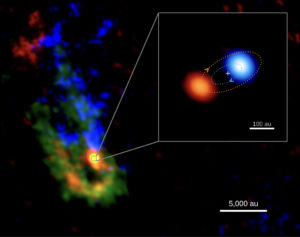
ALMA Image of Young, Massive Binary Star System
ALMA image of the IRAS-07299 star-forming region and the massive binary system at its center. The background image shows dense, dusty streams of gas (shown in green) that appear to be flowing toward the center of the system. Gas that is moving toward us — as traced by the methanol molecule — is shown in blue; motions away from us in red. The inset image shows a zoom-in view of the massive forming binary, with the brighter, primary protostar moving toward us shown in blue and the fainter, secondary protostar moving away from us shown in red. The blue and red dotted lines show an example of orbits of the primary and secondary spiraling around their center of mass (marked by the cross).

